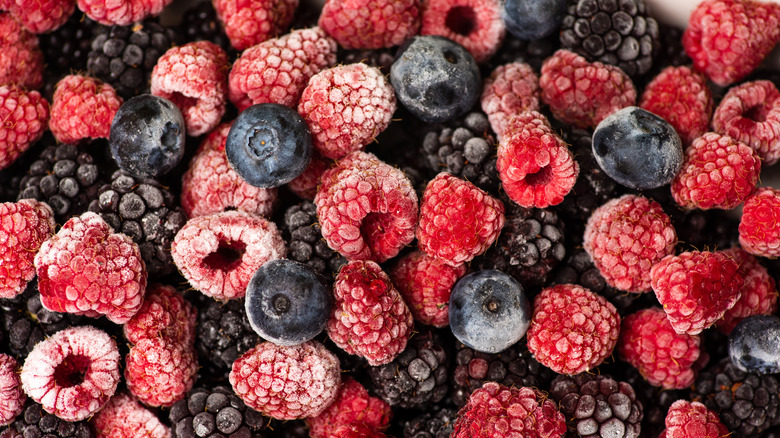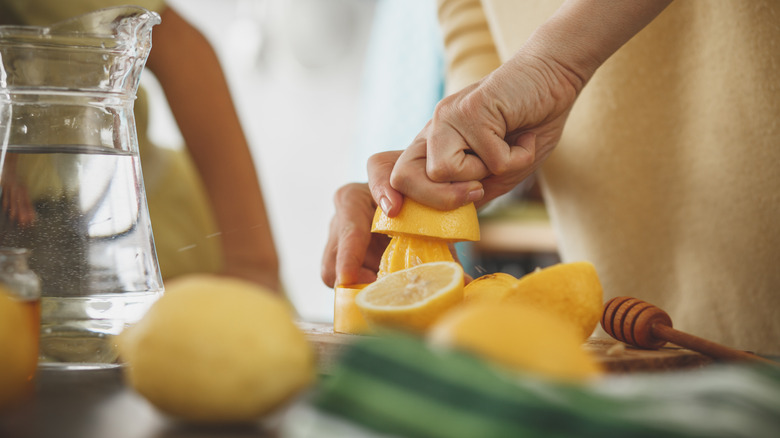The Differences To Note For Thawing Frozen Berries Vs. Citrus
There are two universal truths: No one likes food waste, and everyone likes to enjoy good fruit out of season. Enter frozen fruit. But how do you keep your frozen berries and citrus from becoming a mushy mess when you thaw them?
Berries generally come out quite well when handled properly during thawing — that is, thawed slowly in a refrigerator or cold water bath. It'll take about 12 hours per pint of fruit in the fridge, but the process will go much quicker in cold water because of the increased thermal conductivity. If you need to thaw them very quickly, you can pop them on a plate lined with a paper towel in a single layer, well spaced, and zap them in the microwave for a few seconds on — and this is key — the defrost setting. It's recommended that, if possible, you mostly thaw them but not entirely thaw them for the best structural preservation, if that matters to you.
Thawing citrus, on the other hand, is going to be a rougher time because there's really no way to maintain the integrity of those beautiful little segments. It is, however, a fantastic way to get more juice! Because the juice vesicles are so delicate and there's no getting around it, go ahead and thaw it violently in the microwave for 15 to 20 seconds and juice to your heart's content, or thaw in cold water for 15 to 20 minutes.
Understanding why proper freezing matters in thawing
Have you ever had fingers so cold, they sting and burn when they warm up? God forbid you warm them up too fast; it's the worst. That is what's happening to the cells in your frozen fruit as it thaws.
When water freezes, ice crystals form. It's important to remember that water expands as it freezes, so it's already pushing the cell walls inside, let's say, some berries. The slower the ice forms, the more jagged, long, and sharp the crystals are that push up against those cell walls. They can heavily puncture the cell walls containing the liquid if not frozen properly, leaving a mushy mess. If you've ever wondered why your home-frozen berries thaw into a pile of mush but storebought ones don't (as much), this is a huge differentiator. Your freezer isn't flash-freezing as the commercial outfits do, and the ice crystals are forming like teeny tiny weapons. If your frozen berries could scream and curse as they thawed, as you would in the situation above, they would. Sorry.
If non-mushy fruit matters to you, it's essential that you don't let the fruit thaw and refreeze. Only thaw as much as you need at a time, and don't try to refreeze it. The weakened once-frozen, once-thawed cell walls won't take well to refreezing and re-thawing.
What to do with previously frozen fruit
Frozen, thawed, and juiced citrus can be used in absolutely any way you would use fresh citrus juice, like a lemon curd or a marinade or a margarita. If you need zest from a frozen whole citrus fruit, go ahead and zest before thawing; it'll be easier.
If you're going to use your thawed berries in, say, a fruit salad, don't let them quite thaw all the way. Thaw them gently, and toss together your salad right before the last of the ice has truly melted to keep them from getting wildly mushy and damaged in the process. If you're making a coulis or a compote, there's no need to be precious about it; they're going to be liquified anyway! In fact, a slow freeze and fast thaw will help the process along.
When baking, it's not worth thawing the fruit at all unless the shock of the temperature is going to negatively affect the chemistry of your bake. Things like pancakes and muffins, though? Pie filling? Totally okay to use frozen fruit that you haven't even bothered thawing; it'll actually preserve the structure and help keep the fruit from bleeding into the surrounding batter.


